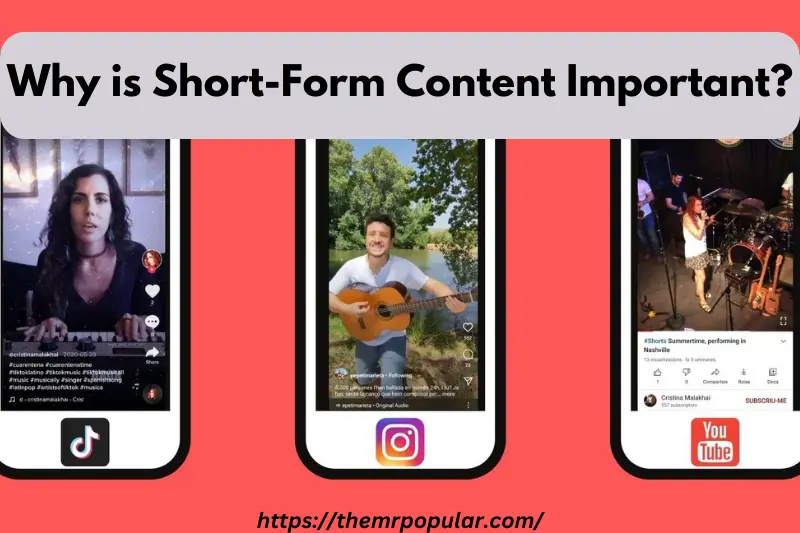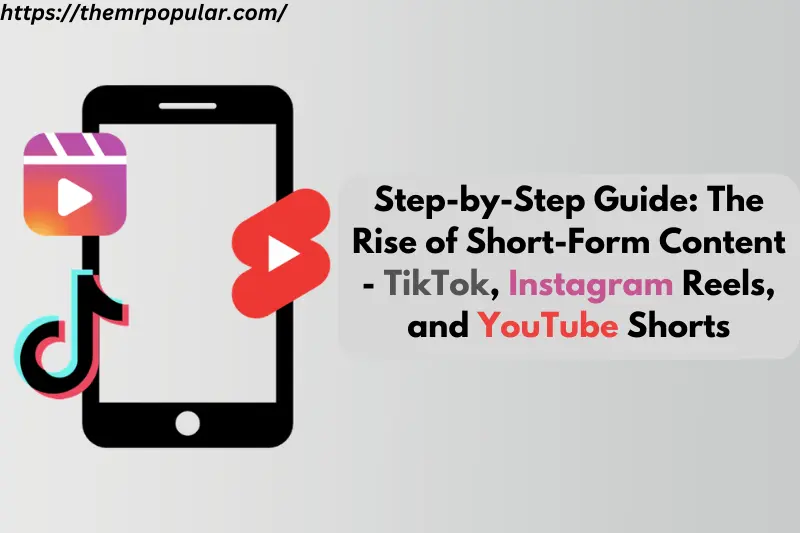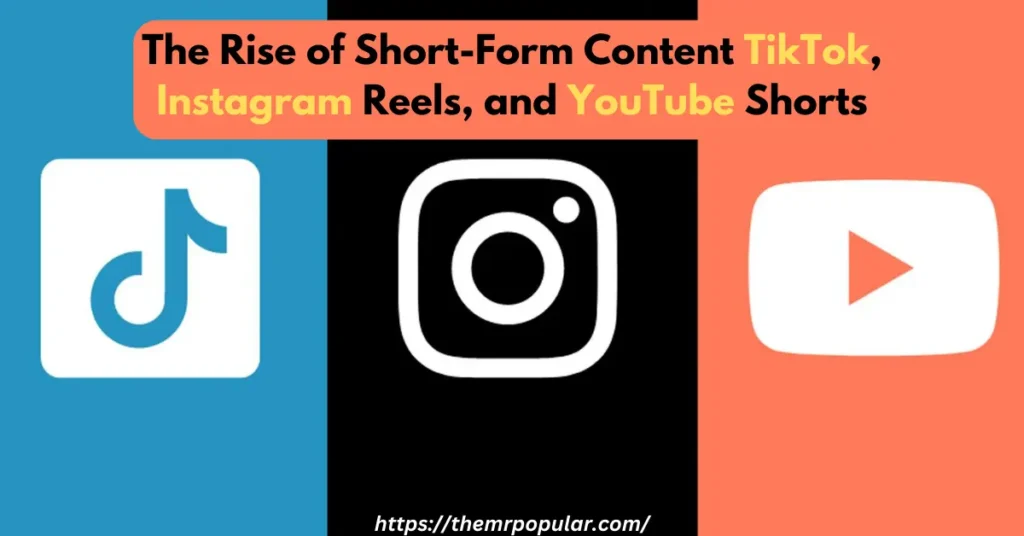Introduction
In recent years, short-form content has taken the digital world by storm, with platforms like TikTok, Instagram Reels, and YouTube Shorts leading the way. But what exactly is short-form content? It refers to engaging videos that are typically under 60 seconds, designed to capture your attention quickly and entertain you on the go.
As our lives become busier and our attention spans shorter, these bite-sized videos have become incredibly popular among users worldwide. Whether it’s a hilarious dance challenge on TikTok, a quick DIY tutorial on Instagram Reels, or a sneak peek into someone’s life on YouTube Shorts, this format allows creators to connect with audiences in a fresh and exciting way.
In this detailed guide, we’ll explore the rise of short-form content and how platforms like TikTok, Instagram Reels, and YouTube Shorts are reshaping the way we consume media. Join us as we dive into the features, trends, and impact of this new wave of digital creativity!
What is “The Rise of Short-Form Content: TikTok, Instagram Reels, and YouTube Shorts”?
The phrase “The Rise of Short-Form Content” refers to the growing popularity and significance of brief video formats that engage viewers quickly and effectively. This trend has been largely driven by platforms like TikTok, Instagram Reels, and YouTube Shorts, which have transformed how users create, share, and consume video content.
TikTok:
Launched in 2016, TikTok has quickly become a cultural phenomenon, especially among younger audiences. Its unique algorithm promotes content based on engagement rather than follower count, allowing anyone to go viral. TikTok’s extensive editing tools, effects, and music integration encourage creativity, making it easy for users to produce entertaining and relatable content in just a few seconds.
Instagram Reels:
In response to TikTok’s success, Instagram introduced Reels in 2020, enabling users to create 15 to 90-second videos. Reels offers similar features, including music, effects, and editing tools, allowing users to showcase their creativity while reaching a broader audience through Instagram’s Explore page. This feature has encouraged brands and influencers to adapt their marketing strategies to leverage the power of short-form videos.
YouTube Shorts:
Launched in 2020 as well, YouTube Shorts caters to users who prefer quick, snackable content. This feature allows creators to upload 60-second vertical videos that can easily be discovered through the YouTube app. YouTube Shorts provides a platform for existing creators to engage their audience in new ways and attract fresh viewers.
Together, these platforms signify a shift in digital content consumption, where users favor quick and entertaining videos over longer formats. The rise of short-form content reflects our evolving preferences for media that is accessible, engaging, and easy to digest, changing how brands connect with audiences and influencing content creation across various industries.
Why is Short-Form Content Important?

Short-form content has become a pivotal part of the digital landscape, and its importance cannot be overstated. Here are several reasons why the rise of TikTok, Instagram Reels, and YouTube Shorts is significant:
Captures Attention Quickly
- Fast-Paced Consumption: In today’s fast-moving world, users prefer content that delivers quick entertainment or information.
- Bite-Sized Format: Short videos fit easily into busy schedules, making it more likely for viewers to watch until the end.
Increases Engagement
- Higher Interaction Rates: Short-form videos often generate more likes, shares, and comments compared to longer videos.
- Viral Potential: Platforms like TikTok and Instagram Reels allow content to go viral quickly, increasing exposure and reach.
Enhances Creativity
- Encourages Innovation: Creators are challenged to convey messages effectively in a limited time, fostering creativity.
- Diverse Content Creation: Short-form content allows for various styles, from tutorials to humor, catering to different audience preferences.
Broadens Audience Reach
- Appeals to Younger Audiences: Platforms like TikTok attract younger demographics, essential for brands targeting Gen Z and millennials.
- Algorithm Support: The algorithms of these platforms promote content based on engagement, allowing creators to reach new audiences without needing a large follower base.
Cost-Effective Marketing Strategy
- Budget-Friendly: Brands can produce short videos with minimal resources, making it accessible for small businesses and startups.
- Quick Campaigns: Short-form content can be created and launched rapidly, allowing brands to capitalize on trends and current events.
Supports Brand Awareness and Loyalty
- Authentic Connections: Short videos can humanize brands, making them more relatable to consumers.
- Memorable Messaging: Engaging and entertaining content is more likely to stick in viewers’ minds, promoting brand recall.
Step-by-Step Guide: The Rise of Short-Form Content – TikTok, Instagram Reels, and YouTube Shorts

Short-form content is revolutionizing how we create and consume media. Here’s a step-by-step guide to understanding and leveraging the rise of TikTok, Instagram Reels, and YouTube Shorts.
Step 1: Understand the Platforms
TikTok
- Overview: A platform for creating and sharing short videos (up to 10 minutes).
- Key Features: Editing tools, music library, filters, and effects.
- Audience: Primarily younger users, especially Gen Z.
Instagram Reels
- Overview: A feature within Instagram for sharing 15 to 90-second videos.
- Key Features: Music integration, effects, and a dedicated Reels tab for discovery.
- Audience: Instagram’s diverse user base, including millennials and Gen Z.
YouTube Shorts
- Overview: A YouTube feature for 60-second vertical videos.
- Key Features: Music options, easy editing tools, and discoverability through the main YouTube app.
- Audience: Existing YouTube users and new viewers looking for quick content.
Step 2: Identify Your Target Audience
- Research Demographics: Understand who uses each platform and tailor your content accordingly.
- Analyze Engagement: Look at what type of content resonates with your target audience on these platforms.
Step 3: Create Compelling Content
Plan Your Content:
- Choose a Theme: Decide on a consistent theme or niche for your content (e.g., comedy, education, lifestyle).
- Brainstorm Ideas: Generate ideas that are entertaining, informative, or relatable.
Keep it Short and Engaging:
- Hook Your Audience: Grab attention within the first few seconds.
- Focus on Storytelling: Even in short videos, tell a clear story or convey a strong message.
Use Editing Tools:
- Explore Features: Use platform-specific tools to add effects, music, and text.
- Keep It Dynamic: Mix up your shots and editing style to maintain viewer interest.
Step 4: Optimize for Each Platform
TikTok:
- Use trending sounds and hashtags to increase discoverability.
- Participate in challenges to boost engagement.
Instagram Reels:
- Share your Reels on your main feed for additional exposure.
- Utilize Instagram Stories to promote your Reels and direct followers to watch.
YouTube Shorts:
- Use relevant keywords in your video title and description for better searchability.
- Leverage existing long-form content to promote your Shorts.
Step 5: Engage with Your Audience
- Respond to Comments: Interact with viewers who comment on your videos to build a community.
- Encourage User-Generated Content: Invite followers to create their own content related to yours (e.g., challenges).
Step 6: Analyze Performance
Track Metrics:
- Monitor views, likes, shares, and comments to evaluate engagement.
- Use analytics tools provided by each platform to gain insights into viewer behavior.
Adjust Strategies:
- Based on your performance metrics, refine your content strategy to improve future videos.
Step 7: Stay Updated on Trends
- Follow Industry Changes: Keep an eye on platform updates, new features, and emerging trends in short-form content.
- Adapt to Shifts: Be flexible in your approach and adapt your content strategy as audience preferences evolve.
See more posts:
How to Start a Successful YouTube Channel in 2024
How to Leverage TikTok for Business: A Beginner’s Guide
Top 10 Instagram Tools to Help You Grow Faster
Understanding Social Media Algorithms: Instagram, YouTube, and More
Advantages and Disadvantages of Short-Form Content: TikTok, Instagram Reels, and YouTube Shorts
Short-form content has transformed the digital landscape, offering unique benefits and challenges for creators and brands. Here’s a breakdown of the advantages and disadvantages of utilizing platforms like TikTok, Instagram Reels, and YouTube Shorts.
| Advantages | Disadvantages |
| Increased Engagement Higher Interaction Rates: Short videos often lead to more likes, shares, and comments compared to longer formats. Quick Consumption: Viewers are more likely to watch short videos in their entirety, boosting engagement. | Limited Depth of Content Superficial Messaging: The brief nature of short-form content may prevent in-depth exploration of topics, potentially leaving viewers wanting more. Less Context: Complex ideas may be difficult to convey in such a short format, risking misinterpretation. |
| Wider Reach Viral Potential: The algorithms on these platforms promote trending content, allowing creators to reach larger audiences quickly. Diverse Audience: Platforms like TikTok and Instagram attract a variety of age groups, expanding potential viewer demographics. | High Competition Oversaturation: The popularity of short-form content means there’s a vast amount of competition, making it challenging for creators to stand out. Trend Dependency: Creators may feel pressured to constantly adapt to trends, which can dilute their unique voice or brand identity. |
| Cost-Effective Content Creation Lower Production Costs: Creating short videos typically requires fewer resources than longer formats. Quick Turnaround: Content can be produced and posted rapidly, allowing creators to capitalize on current trends. | Short Attention Spans Evolving Expectations: As audiences become accustomed to rapid-fire content, maintaining attention can become increasingly difficult. Content Fatigue: Users may experience fatigue from consuming too much short-form content, leading to decreased engagement over time. |
| Enhanced Creativity Encourages Innovation: The challenge of conveying a message in a short time frame fosters creative thinking among creators. Diverse Content Formats: Short-form content allows for experimentation with various styles and formats, such as tutorials, skits, or challenges. | Platform Limitations Algorithm Changes: Changes in platform algorithms can significantly impact the visibility of content, making it unpredictable for creators. Content Guidelines: Strict content policies may restrict the types of content that can be posted, limiting creative freedom. |
| Brand Awareness and Loyalty Authentic Connections: Short videos can humanize brands, making them more relatable and engaging for audiences. Memorable Messaging: Catchy and entertaining content is more likely to leave a lasting impression on viewers. | Monetization Challenges Limited Revenue Opportunities: Short-form content may not always provide significant monetization options compared to longer formats. Brand Partnerships: Some brands may prefer traditional advertising methods or longer videos, leading to fewer collaboration opportunities. |
| Effective Marketing Tool Trend Utilization: Brands can leverage popular trends and challenges to enhance visibility and engagement. Targeted Advertising: Short-form content can be used strategically in ads to quickly capture consumer interest. | Potential for Miscommunication Lack of Nuance: Due to the brevity of short-form content, creators may struggle to convey complex ideas, leading to misunderstandings or oversimplifications. Misinterpretation: Viewers may misinterpret content, especially if it relies on humor or context that may not be universally understood. This can lead to negative feedback or backlash, affecting the creator’s reputation. |
Common FAQs about Short-Form Content: TikTok, Instagram Reels, and YouTube Shorts
Here are some frequently asked questions about short-form content on TikTok, Instagram Reels, and YouTube Shorts:
What is short-form content?
Short-form content refers to videos that are typically under 60 seconds. These videos are designed to be quick, engaging, and easily consumable, perfect for our fast-paced digital world.
Why is short-form content so popular?
Short-form content is popular because it captures attention quickly, is easy to watch, and allows for creativity. People enjoy quick entertainment, and platforms like TikTok, Instagram Reels, and YouTube Shorts cater to this demand.
How can I create engaging short-form videos?
To create engaging short-form videos:
Start with a strong hook to grab attention.
Keep your content clear and focused.
Use editing tools and effects to make your video visually appealing.
Experiment with different styles and trends to find what resonates with your audience.
Can businesses benefit from short-form content
Yes! Businesses can use short-form content to increase brand awareness, engage with customers, and promote products or services. It allows brands to connect with audiences in a fun and relatable way.
How do I get more views on my short-form videos?
To increase views on your videos:
Use trending sounds and hashtags.
Engage with your audience through comments and challenges.
Post consistently and at times when your audience is most active.
Collaborate with other creators to expand your reach.
Is short-form content suitable for all types of brands?
While short-form content can work for most brands, it’s essential to adapt the content style to fit your brand’s identity. Creative storytelling and engaging visuals can help convey your message effectively, regardless of your industry.
What equipment do I need to create short-form videos?
You don’t need expensive equipment to create short-form videos. A smartphone with a good camera and basic editing apps can be enough to get started. As you grow, you can invest in better equipment if desired.
What are some common mistakes to avoid when creating short-form content?
Some common mistakes include:
Overcomplicating your message.
Ignoring audience engagement.
Failing to keep up with trends.
Neglecting to promote your videos on other platforms.
How can I measure the success of my short-form content?
You can measure success by tracking metrics such as views, likes, shares, comments, and follower growth. Each platform provides analytics tools to help you understand your audience’s behavior and engagement.
Will short-form content continue to be relevant in the future?
Yes, short-form content is likely to remain relevant as audience preferences shift toward quick and engaging formats. Keeping an eye on trends and adapting your content strategy will help you stay ahead in the ever-evolving digital landscape.
Bonus Points on Short-Form Content: TikTok, Instagram Reels, and YouTube Shorts
Here are some bonus points to enhance your understanding and strategy for creating effective short-form content:
Stay Authentic
- Authenticity resonates with audiences. Be yourself and showcase your personality to build trust and relatability with viewers.
Utilize Analytics
- Regularly review your analytics to understand what works and what doesn’t. Adjust your content strategy based on performance insights to improve future videos.
Engage with Trends
- Participating in trending challenges or using popular sounds can increase your chances of going viral. Keep an eye on trends within each platform and jump on them quickly.
Create a Strong Brand Identity
- Consistent branding in your videos (like color schemes, fonts, and logos) helps viewers recognize your content and build brand loyalty over time.
Experiment with Content Formats
- Try different formats, such as behind-the-scenes footage, tutorials, Q&As, or quick tips. Variety keeps your audience engaged and curious about what you’ll share next.
Incorporate User-Generated Content
- Encourage your audience to create their own videos related to your content or challenges. This not only boosts engagement but also creates a sense of community around your brand.
Optimize for Mobile Viewing
- Since most users watch short-form content on their mobile devices, ensure your videos are visually appealing and easy to view on smaller screens. Use vertical formats and clear visuals.
Plan for Cross-Promotion
- Promote your short-form videos across your other social media platforms. Encourage followers from one platform to check out your content on another to grow your audience.
Leverage Call-to-Actions (CTAs)
- Include clear CTAs in your videos, directing viewers to like, share, comment, or follow. This can significantly increase engagement and help grow your following.
Stay Updated on Platform Changes
- Social media platforms frequently update their features and algorithms. Stay informed about these changes to optimize your content strategy and maintain visibility.
Conclusion
The rise of short-form content on TikTok, Instagram Reels, and YouTube Shorts has changed the way we create and consume videos. These platforms offer exciting opportunities for creativity, engagement, and brand growth. By understanding your audience, creating authentic content, and staying updated on trends, you can effectively leverage short-form videos to connect with viewers and expand your reach. Embrace the fun and dynamic nature of short-form content to make a lasting impact in the digital world!
